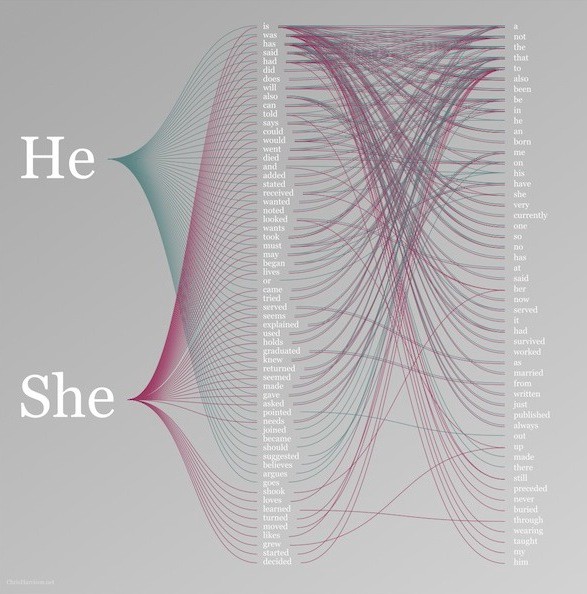Analyzing Women and Men With Google Ngram’s Help
by Liz Colville

Google’s Ngram tool is pretty amazing if you know what to do with it, I realized once I saw this chart created by a Human-Computer Interaction PhD student by the name of Chris Harrison (not the Bachelor host, sadly, though their lines of work are quite similar). Harrison used Ngram, which allows you to search the texts of billions of books, to look at how women and men are portrayed in writing. Specifically, what are the most common trigrams (sets of three words) for each gender and what do those trigrams tell us about ourselves?
Harrison says:
among the top 120 trigrams, ‘He’ and ‘She’ have many common second words. However, they differ on some interesting ones, for example, only ‘he’ connects to ‘argues’, while only ‘she’ connects to ‘love.’
Not all that surprising: Glamour tells us in an article about how men want other things apart from sex that men sometimes “need help getting to” the words “I love you.” Mmmm.
It’s a complicated chart to read — it’s pretty hard to follow the second words to the third words, so let’s just look at the second words. Men have a hold of the verbs “joined” (the military?), “became” (a doctor?), “suggested” (she shut the hell up?), “believes” (he is the best?), and “goes” (away to his mistress’s house?), while women dominate the verbs “learned” (how to sew?), “turned” (around in her pretty dress so that he could see just a hint of her stockinged ankles beneath her petticoat?), “moved” (toward the window so that he could not see her cry?), “grew” (frightened?), and “started” (to cry?).
Check out a PDF of the chart here.
[Via]